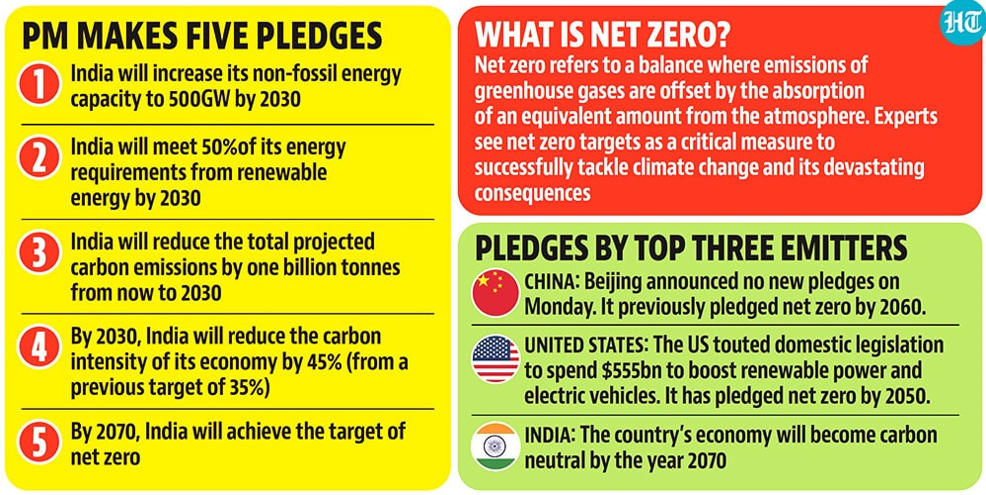Context:
The launch of the report on energy transitions towards achieving India’s net-zero targets marks a significant milestone in India’s energy landscape.
Initiative and Funding:
- The report titled “Synchronizing energy transitions towards possible Net-Zero for India: Affordable and clean energy for All” was prepared by IIM Ahmedabad under the guidance of the Office of the Principal Scientific Adviser to the Government of India.
- It received partial funding from the Nuclear Power Corporation of India Ltd (NPCIL), highlighting collaborative efforts between government and industry.
Objective:
- The report aimed to analyze the energy transition required for India to achieve a net-zero energy basket, focusing on minimizing consumer-end power costs and determining an optimum power source mix.
Key summary of the report:
- There is no silver bullet to achieve net zero. The transition needs multiple pathways to be adopted with the co-existence of myriad technologies in our energy basket.
- Coal is projected to continue until the next two decades as the backbone of the Indian energy system.
- Net zero is not possible without substantial nuclear power and Renewable Energy (RE) generation by 2070.
- The mathematic modeling calculated that the emissions in 2070 fell to 0.55 billion tonnes of carbon dioxide (‘net zero’ scenario). This translated to nuclear power rising five-fold from today’s levels to 30 GW (gigawatt) by 2030 and 265 GW by 2050.
- To put in perspective, it means nuclear power will contribute 4% of India’s total energy by 2030 and sharply rise to 30% by 2050. In the same scenario, the share of solar power falls from 42% in 2030 to 30% in 2050.
- India’s emissions would range between 0.56 btCO2 and 1.0 btCO2 in 2070. It is expected that the remaining gap in emissions will be offset through sequestration in forestry and tree cover as envisaged in our INDIA’s Nationally Determined Contributions (INDCs).
- Additionally, the coal phase-down will require active policies on critical minerals and carbon dioxide removal technologies.
- Clean, affordable electricity at low levelized cost of electricity (for consumers) can be achieved in net-zero pathways, especially with a focus on nuclear power and renewable power.
- Widespread electrification of end-use sectors i.e upto 47-52% electricity share in Total Final Electricity Consumption (TFEC) compared to 18% at present.
- Between 2020 and 2070, India would require approximately ₹150-200 lakh crore to fund these transitions

Challenges and Solutions:
Grid Integration: Integrating a high share of variable renewable energy (solar and wind) requires:
- Smart Grid Technologies: Advancements in grid management and storage solutions to handle fluctuations in renewable energy generation.
- Inter-State Grid Connectivity: Improved transmission infrastructure to facilitate power exchange between states with surplus and deficit renewable energy.
Energy Access and Equity: Ensuring everyone has access to affordable and clean energy sources for cooking, heating, and lighting.
- Targeted Programs: Subsidies or financing schemes for rural electrification and clean cooking solutions like LPG.
- Decentralized Renewable Energy: Promoting off-grid solar solutions for remote areas.
Policy and Regulatory Measures:
- Mission Mode Approach: Continued government commitment through missions like the National Hydrogen Mission and Green Hydrogen Mission.
- Renewable Energy Purchase Obligations (RPOs): Mandates on electricity distribution companies to purchase a certain percentage of their electricity from renewable sources.
- Carbon Pricing: Implementing carbon pricing mechanisms (e.g., carbon tax) to incentivize cleaner energy sources.
- Research and Development (R&D): Investment in R&D for clean energy technologies, including advanced energy storage solutions and next-generation nuclear power technology.
Conclusion:
Overall, the report provides a comprehensive roadmap for India’s transition to a net-zero energy future, emphasizing collaboration between government, industry, and research institutions.

